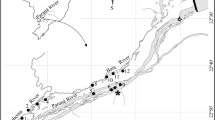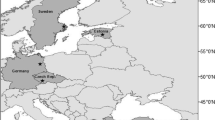Abstract
The mid-summer disappearance of Daphnia and the small size of cladocerans in subtropical lakes have been explained as phenomena caused by high water temperature. Recent experimental and observational studies suggest that instead, fish predation could be the cause. In the present study, we evaluated effects of temperature and fish predation by comparing summer occurrence of Daphnia and seasonality of other cladocerans in subtropical lakes where there was (a) vegetation and a high abundance and diversity of planktivorous fish; versus (b) no vegetation, turbid water, and primarily benthivorous and piscivorous fish. Daphnia disappeared from mid-summer plankton samples at all locations with vegetation, yet it persisted year-round at the turbid vegetation-free location despite identical water temperatures (all lakes were shallow and isothermal). Body size of cladocerans, in general, was twofold lower at vegetated locations, and biomass was threefold lower. Smaller species dominated at the locations with vegetation, especially in summer. Our results demonstrate that in subtropical lakes Daphnia is able to tolerate high summer water temperatures, and suggest that fish predation may be a more important regulator than temperature for cladoceran size, biomass and taxonomic structure.








Similar content being viewed by others
References
Aldridge, F. J., E. J. Phlips & C. L. Schelske, 1995. The use of nutrient enrichment bioassays to test for spatial and temporal distribution of limiting factors affecting the phytoplankton dynamics in Lake Okeechobee, Florida. Archiv für Hydrobiologie 45: 177–190.
Allen, M. S., M. V. Hoyer & D. E. Canfield Jr., 2000. Factors related to gizzard shad and threadfin shad occurrence and abundance in Florida lakes. Journal of Fish Biology 57: 291–302.
Beaver, J. R., D. A. Casamatta, T. L. East, K. E. Havens, A. J. Rodusky, R. T. James, C. E. Tausz & K. M. Buccier, 2013. Extreme weather events influence the phytoplankton community structure in a large lowland subtropical lake (Lake Okeechobee, Florida, USA). Hydrobiologia 709: 213–226.
Brooks, J. L. & S. I. Dodson, 1965. Predation, body size, and composition of plankton. Science 150: 28–35.
Bull, L. A., D. D. Fox, D. W. Brown, L. J. Davis, S. J. Miller & J. G. Wullschleger, 1995. Fish distribution in the limnetic areas of Lake Okeechobee, USA. Archiv für Hydrobiologie 45: 333–342.
Clarke, K. R. & R. N. Gorley, 2006. User manual/tutorial. PRIMER-E Ltd., Plymouth, MA.
Conrow, R., A. V. Zale & R. W. Gregory, 1990. Distributions and abundances of early life stages of fishes in a Florida lake dominated by aquatic macrophytes. Transactions of the American Fisheries Society 119: 521–528.
Crisman, T. L., 1992. Natural lakes of the southeastern United States: origin structure and function. In Hackney, C.T., S. M. Adams & W. A. Martin (eds), Biodiversity of Southeastern United States Aquatic Communities. Wiley, New York: 475–538.
Foran, J. A., 1986. A comparison of the life history features of a temperate and a subtropical Daphnia species. Oikos 46: 185–193.
Fry, B., P. L. Mumford, F. Tam, D. D. Fox, G. L. Warren, K. E. Havens & A. D. Steinman, 1999. Trophic position and individual feeding histories of fish from Lake Okeechobee, Florida. Canadian Journal of Fisheries and Aquatic Sciences 56: 590–600.
Gillooly, J. F. & S. I. Dodson, 2000. Latitudinal patterns in the size distribution and seasonal dynamics of new world, freshwater cladocerans. Limnology and Oceanography 45: 22–30.
Gliwicz, Z. M. & A. Rykowska, 1992. Shore avoidance in zooplankton: a predator-induced behavior or predator-induced mortality? Journal of Plankton Research 14: 1331–1342.
Hart, R. C. & E. A. Bychek, 2011. Body size in freshwater planktonic crustaceans: an overview of extrinsic determinants and modifying influences of biotic interactions. Hydrobiologia 668: 61–108.
Havens, K. E. & J. R. Beaver, 2011. Composition, size and biomass of zooplankton in large productive Florida lakes. Hydrobiologia 668: 49–60.
Havens, K. E. & T. Hanazato, 1993. Zooplankton responses to chemical stressors: a comparison of results from acidification and pesticide contamination research. Environmental Pollution 82: 277–288.
Havens, K. E., T. L. East & J. R. Beaver, 1996. Experimental studies of zooplankton-phytoplankton-nutrient interactions in a large subtropical lake (Lake Okeechobee, Florida, USA). Freshwater Biology 36: 579–597.
Havens, K. E., T. L. East, J. Marcus, P. Essex, B. Bolan, S. Raymond & J. R. Beaver, 2000. Dynamics of the exotic Daphnia lumholtzi and native macro-zooplankton in a subtropical chain-of-lakes in Florida, USA. Freshwater Biology 45: 21–32.
Havens, K. E., K. R. Jin, A. J. Rodusky, B. Sharfstein, M. A. Brady, T. L. East, N. Iricanin, R. T. James, M. C. Harwell & A. D. Steinman, 2001. Hurricane effects on a shallow lake ecosystem and its response to a controlled manipulation of water level. The Scientific World Journal 1: 44–70.
Havens, K. E., T. L. East & J. R. Beaver, 2007. Zooplankton response to extreme drought in a large subtropical lake. Hydrobiologia 589: 187–198.
Havens, K. E., J. R. Beaver, D. A. Casamatta, T. L. East, R. T. James, P. McCormick, E. J. Phlips & A. J. Rodusky, 2011. Hurricane effects on the planktonic food web of a large subtropical lake. Journal of Plankton Research 33: 1081–1094.
Havens, K. E., R. M. Pinto-Coelho, M. Beklioglu, K. S. Christoffersen, E. Jeppesen, T. L. Lauridsen, A. Mazumder, G. Methot, B. Pinel-Alloul, U. N. Tavsanoglu, S. Erdogan & J. Vijverberg, 2015. Temperature effects on body size of freshwater crustacean zooplankton from Greenland to the tropics. Hydrobiologia 743: 27–35.
Iglesias, C., N. Mazzeo, M. Meerhoff, G. Lacerot, J. M. Clemente, F. Scasso, C. Kruk, G. Goyenola, J. García-Alonso, S. L. Amsinck, J. C. Paggi, S. J. de Paggi & E. Jeppesen, 2011. High predation is of key importance for dominance of small-bodied zooplankton in warm shallow lakes: evidence from lakes, fish exclosures and surface sediments. Hydrobiologia 667: 133–147.
James, R. T. & K. E. Havens, 2005. Outcomes of extreme water levels on water quality of central pelagic and near-shore regions in a large shallow subtropical lake. Archiv für Hydrobiologie 163: 225–239.
Jeppesen, E., J. P. Jensen, M. SØndergaard, M. Fenger-Gron, M. E. Bramm, K. Sandby, P. H. MØller & H. U. Rasumssen, 2004. Impact of fish predation on cladoceran body weight distribution and zooplankton grazing in lakes during winter. Freshwater Biology 49: 432–447.
Jeppesen, E., M. Meerhoff, B. A. Jacobsen, R. S. Hansen, M. SØndergaard, J. P. Jensen, T. L. Lauridsen, N. Mazzeo & C. W. C. Branco, 2007. Restoration of shallow lakes by nutrient control and biomanipulation – the successful strategy varies with lake size and climate. Hydrobiologia 581: 269–285.
Kirk, K. L. & J. J. Gilbert, 1990. Suspended clay and the population dynamics of planktonic rotifers and cladocerans. Ecology 71: 1741–1755.
Lacerot, G. 2010. Effects of climate on size structure and functioning of aquatic food webs. PhD thesis, Wageningen University, Wageningen: 98.
McCauley, E., 1984. The estimation of the abundance and biomass of zooplankton in samples. In Downing, J. A. & F. H. Rigler (eds), A Manual for the Assessment of Secondary Productivity in Fresh Waters. Blackwell Scientific, Oxford: 228–265.
Meerhoff, M., C. Iglesias, F. Teixeira de Mello, J. M. Clemente, E. Jensen, T. L. Lauridsen & E. Jeppesen, 2007. Effects of habitat complexity on community structure and predator avoidance behavior of littoral zooplankton in temperate versus subtropical shallow lakes. Freshwater Biology 52: 1009–1021.
Miner, J. G. & R. A. Stein, 1993. Interactive influence of turbidity and light on larval bluegill (Lepomis macrochirus) foraging. Canadian Journal of Fisheries and Aquatic Sciences 50: 781–788.
Moore, M. V., C. F. Folt & R. S. Stemberger, 1996. Consequences of elevated temperatures for zooplankton assemblages in temperate lakes. Archiv für Hydrobiologie 135: 289–319.
Phlips, E. J., F. J. Aldridge, P. Hansen, P. V. Zimba, J. Ihnat, M. Conroy & P. R. Ritter, 1993. Spatial and temporal variability of trophic state parameters in a shallow subtropical lake (Lake Okeechobee, Florida, USA). Archiv für Hydrobiologie 128: 437–458.
Pine, W. E. & M. S. Allen, 2001. Differential growth and survival of weekly age-0 black crappie cohorts in a Florida lake. Transactions of the American Fisheries Society 130: 80–91.
Rogers, M. W. & M. S. Allen, 2011. An ecosystem model for exploring lake restoration effects on fish communities and fisheries in Florida. Restoration Ecology. doi:10.1111/j.1526-100X.2011.00819.x.
Sarma, J. B., D. S. Gruner & H. Hillebrand, 2005. All wet or dried up? Real differences between aquatic and terrestrial food webs. Proceedings of the Royal Society 273: 1–9.
Sosnovsky, A., J. J. Rosso & R. Quirós, 2010. Trophic interactions in shallow lakes of the Pampa plain (Argentina) and their effects on water transparency during two cold seasons of contrasting fish abundance. Limnetica 29: 233–246.
Tugend, K. I. & M. S. Allen, 2000. Temporal dynamics of zooplankton community composition and mean size in Lake Wauberg, Florida. Florida Scientist 63: 142–154.
USEPA, 1979. Methods for Chemical Analysis of Water and Waste Water. United States Environmental Protection Agency, Washington: 490.
Vinyard, G. L. & W. J. O’Brien, 1976. Effects of light and turbidity on the reactive distance of bluegill (Lepomis macrochirus). Journal of the Fisheries Research Board of Canada 33: 2845–2849.
Zaret, T. M., 1980. Predation and Freshwater Communities. Yale University Press, New Haven, CT.
Acknowledgments
The authors are grateful to two anonymous reviewers for constructive comments on an earlier draft of this paper; to the environmental monitoring staff at the South Florida Water Management District for collecting plankton samples, and for collecting and processing samples for nutrients and Chl-a; and to Amy Peters for creating the site map.
Author information
Authors and Affiliations
Corresponding author
Additional information
Guest editor: Koen Martens / Emerging Trends in Aquatic Ecology
Rights and permissions
About this article
Cite this article
Havens, K.E., Beaver, J.R., Manis, E.E. et al. Inter-lake comparisons indicate that fish predation, rather than high temperature, is the major driver of summer decline in Daphnia and other changes among cladoceran zooplankton in subtropical Florida lakes. Hydrobiologia 750, 57–67 (2015). https://doi.org/10.1007/s10750-015-2177-5
Received:
Revised:
Accepted:
Published:
Issue Date:
DOI: https://doi.org/10.1007/s10750-015-2177-5




